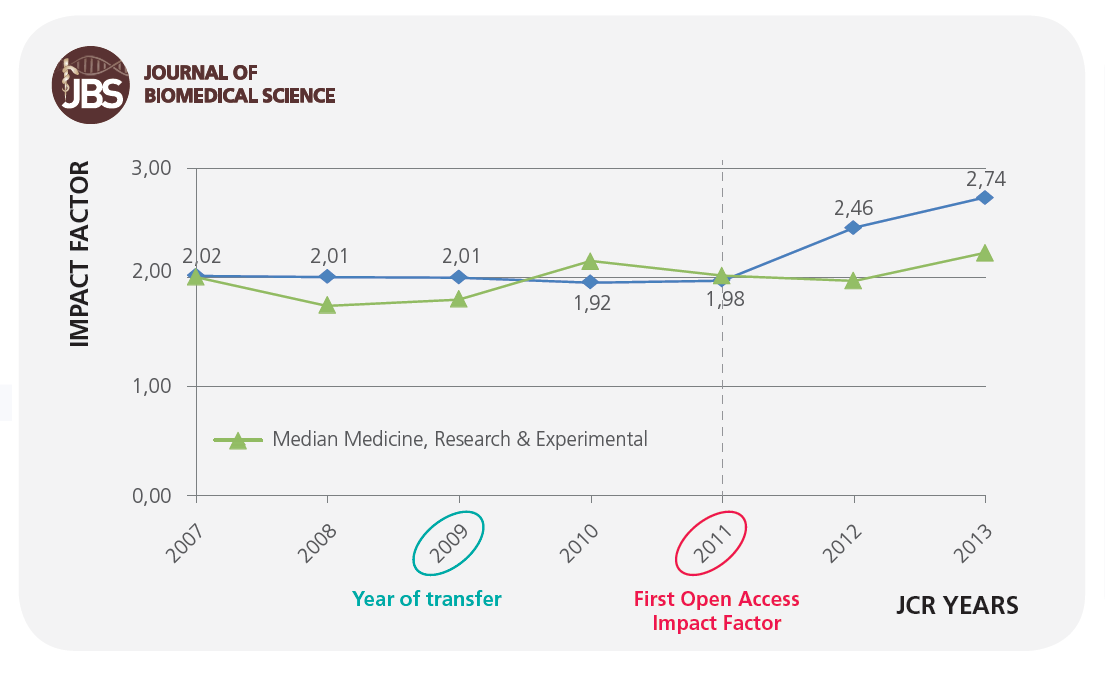This means that, unlike the Impact Factor, SNIP numbers can be compared for any two journals, regardless of the field they are in. SNIP is defined as the ratio of the raw Impact per Publication divided by the Relative Database Citation Potential. International Scientific Journal Country Ranking. International Scientific Journal Country Ranking. also developed by scimago: Scimago Institutions Rankings. Scimago Journal Country Rank Only Open Access Journals Only SciELO Journals Only WoS Journals. Display journals with at least. (3years) Total Cites (3years) Apply. Overall, our journals rank at the 72nd Impact Factor percentile on average and as high as the 91st percentile. Figure 4: Analysis of Impact Factor rankings. A total of 11, 655 journals are indexed in the 2017JCR (released in 2018 by Clarivate Analytics). Impact factor data is only available for journals indexed by Web of Science. The default display is organized alphabetically by journal title, changing the option to Impact Factor will rank the journals from most impact to least. Clicking on a journal title will provide additional details about the calculation. ISSN Research Journal Impact Factor (RJIF) provides quantitative and qualitative tool for ranking, evaluating and categorizing the journals for academic evaluation and excellence. This factor is used for evaluating the prestige of journals. The evaluation is carried out by considering the factors like peer review originality, scientific quality, technical editing quality, editorial quality and. Source Normalized Impact per Paper (SNIP) measures contextual citation impact by weighting citations based on the total number of citations in a subject field. It helps to compare a journal with competing journals in a subject area. A journal's impact factor is a measure of the frequency with which an average article in a journal has been cited in a particular year. The following list highlights some. The median Impact factor is the median value of all journals impact factors in the subject category. The journal impact factor extenuates the significance of absolute citation frequencies. It alleviates the advantage of large journals over small journals because large. These rankings covers journals, book series, book chapter series, working paper series, and software component series that are indexed in RePEc. You may compute your own summary ranking in the sandbox by choosing what methods to include and how to aggregate them. Simple impact factors: all years, last 10 years; Recursive. Bogus Impact Factor Cites Just as you may be aware of predatory journals, seeking to make money from academics eager to be published, fake impact factor cites have appeared on the web. When trying to determine where to publish try as much as possible to use wellknown journal ranking resources. Thomson Scientific (ISI) Journal Citation Reports a ranking of journals relevant for business researchers based on judgments by the members of the German Academic Association for Business Research. Factors considered are the aim and scope of the journal, the quality of its board, the SCCI impact factor. The impact factor (IF) is a measure of the frequency with which the average article in a journal has been cited in a particular year. It is used to measure the importance or rank of a journal by calculating the times it's articles are cited. Journals appearing in JCR A complete list of the titles covered in this year's JCR is available here A list of journals receiving their first Journal Impact Factor is available here Medicine Journal Impact Factor List provide the complete list of journals with last 10 years impact factor, hindex and sjr impact factor. The impact factor is a measure of the frequency with which the average article in a journal has been cited in a particular year. The JCR also lists journals and their impact factors and ranking in the context of their specific field(s). Physics journals published by OMICS group are Open Access having impact factors publishes high quality research and scientific content in physical sciences. The report includes more than 11, 000 journals from 81 countries. The most wellknown indicator in the JCR is the Journal Impact Factor (JIF). This measure provides a ratio of citations to a journal in a given year to the citable items in the prior two years. PeerJ's 2016 Impact Factor is 2. 2 (see Journal Citation Reports). Whilst we appreciate the importance still placed on the Impact Factor by many elements of the academic community, we believe that individual research articles are best assessed on their own merits, rather than on an aggregate citation count for the journal in which the work is published. Check the latest impact factors for journals at the following link. How to know journal ranking Q1, Q2, Q3 and Q4 from web of science? Does somebody have the Impact factor 2017 in XLS. Impact Factor Ranking Results From the Journal Citation Reports, 2018 release, a Clarivate Analytics product In the 2018 reports, 12 SAGE journals were added, bringing the total number ranked to 597, a 28 increase over the past five years. Journal ranking is primarily devised for the purpose of evaluating the quality or impact of journals in specific fields. The most common ranking systems for orthopaedic journals are those based on citation metrics, such as the journal impact factor (JIF) [from Science Citation Index (SCI) by Thompson Reuters or the SCImago Journal Rank (SJR) indicator (by Elsevier). Thank you for continuing to publish your best work in Royal Society of Chemistry journals. Browse through our portfolio by subject and see what youve helped us to achieve. The correlation between impact factors in SCImago and JCR is very large (about 0. 99 in a sample I took of 64 economics journals). I cannot present here a JCR impact factor of the Journal of SocioEconomics because the journal is not yet included in JCR (I do not know for what reasons). Emerald journals continue to demonstrate their impact within the academic research community. We are pleased to report a range of increased Impact Factors for 2017, across a wide variety of disciplines. Journal Impact Factor discipline rankings lists all of the journals in a discipline based on their JIF. These rankings are available through Journal Citation Reports. To find rankings for a discipline from the home page, choose the Select Category option on the left, then choose a category to display (as shown), then hit Submit (at the bottom of the page). An impact factor is a metric for ranking scientific journals. Impact factors are calculated for every twoyear period by dividing the number of times articles were cited by the number of. Sort journal data by clearly defined fields: Impact Factor, Immediacy Index, Total Cites, Total Articles, Cited HalfLife, or Journal Title. Ranking is based on Impact Factor. Vanity press and poorquality journals are not listed To provide a simple yet more objective way to rank journals within and among disciplines, we developed a resampled composite journal rank incorporating five popular citation indices: Impact Factor, Immediacy Index, SourceNormalized Impact Per Paper, SCImago Journal Rank and Google 5year hindex; this approach provides an index of relative. The Lancets 2013 impact factor is 39. 207, ranking the journal second in the general medicine category. Its very difficult to be published in The Lancet. Only 5 of submitted manuscripts accepted for publication in the Lancet family of nine general medicine specialty journals. Journal Ranking Impact Factors Printed Monday, 27 July 2015 Page 3 1 Why are journal rankings impact factors useful? To identify journals in which to publish: journal rankingsimpact factors can indicate which publications receive higher rates of citations. Mathematics Journals Share this page Mathematics is a fundamental branch of science that represents the study of basic concepts of numbers, space and quantity as well as application of these concepts in the fields of physics and engineering. Journals: Impact Factor: ISSN: Publisher Name: INDIAN JOURNAL OF COMMUNITY HEALTH: 2017 1. 759 (2017) International Scientific Indexing (ISI) INTERNATIONAL JOURNAL OF PUBLIC HEALTH AND CLINICAL SCIENCES: 2017 0. 565 Net Journals: JOURNAL OF CARDIOLOGY CARDIOVASCULAR THERAPY (JOCCT) 2017 0. 814 (2017) 5Year Impact Factor: 5. 582 FiveYear Impact Factor: 2017: 5. 582 To calculate the five year Impact Factor, citations are counted in 2017 to the previous five years and divided by the source items published in the previous five years. Science Gateway Home The most relevent web site for biomedical research with medline search, journals, textbooks, database A quantitative and qualitative tool for ranking, evaluating and comparing scientific journals. SJIF Journal Rank It contains currently over journals from all over the world. Celebrating another successful year of Public Health Impact Factors from Oxford University Press. The 2017 Impact Factors from the 2017 Journal Citation Reports (Clarivate Analytics, 2018) have been released, and its been another great year for Oxford University Press Public Health journals with a number of titles achieving an increase. The impact factor is a very useful tool for evaluation of journals, but it must be used discreetly. Considerations include the amount of review or other types of material published in a journal, variations between disciplines, and itembyitem impact. Impact Factor List 2015 2014 2012 2013 2011 Journal Impact Factor (IF) is a measure reflecting the average number of citations to articles published in science and social science journals. Here we deploy the fiveyear impact factor to identify a ranking of the 20 journals in history with the most influence, according to a citationsperpaper measure. The fiveyear impact factor is calculated as the number of citations in year 6 to all papers in a specific journal in years 1 through 5, divided by the number of citable articles in. The ranking of social science journals can be found in a variety of places, including SCImago, ISI Journal Citation Reports, and so on. For information on journals that are cited frequently, use Harzings Publish or Perish software. International Scientific Journal Country Ranking. Only Open Access Journals Only SciELO Journals Only WoS Journals The Journals Impact Factor (JIF) provides a reflecting tools for ranking, categorizing, evaluating, and comparing various Journals having ISSN published by Learning societies Universities and Institutions Publication house. The CiteFactor server provides indexing of major international journals and proceedings. Author can get information about international journal impact factor, proceedings (research papers) and information on upcoming events. All the journal pages have pointers to Web pages of the publishers which are integrated into the CiteFactor stream pages. The impact factor (IF) or journal impact factor (JIF) of an academic journal is a measure reflecting the yearly average number of citations to recent articles published in that journal. It is frequently used as a proxy for the relative importance of a journal within its field; journals with higher impact factors are often deemed to be more. The impact factor (IF) or journal impact factor (JIF) of an academic journal is a measure reflecting the yearly average number of citations to recent articles published in that journal..











